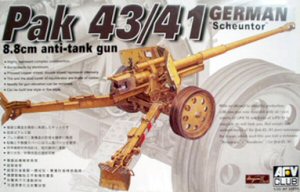
AFV Club 1/35 German 8.8cm Pak 43/41 Anti-Tank Gun Kit First Look
By Cookie Sewell
| Date of Review | October 2005 | Manufacturer | AFV Club |
|---|---|---|---|
| Subject | German 8.8 cm Pak 43/41 Anti-Tank Gun | Scale | 1/35 |
| Kit Number | 35059 | Primary Media | 288 parts (230 in olive drab styrene,11 in etched brass, 2 black acetal tubes, 2 brass rods, 2 black vinyl tires, 1 turned aluminum barrel) |
| Pros | First plastic kit of this weapon; amazing level of detail provided; innovate new methods for packaging | Cons | Many modelers who hate “fiddly” bits not going to be happy with gun shield construction |
| Skill Level | Intermediate | MSRP (USD) | Approx $40 |
First Look
Imagine the frustration of famed German General Erhard Raus in 1941 when he came face to face with a Soviet KV-1 that turned into a pillbox and kept his division from advancing. He was horrified at how many troops and weapons had to be sacrificed to knock it out, and even after repeated damage it survived. Even the vaunted 88 – the 8.8 cm FlaK 36/37 combination antiaircraft antitank gun – had only penetrated its armor with 3 out of 10 rounds, and in the end the tank was finished off by an infantryman who slipped a grenade into one of the 88 penetration holes.
The German planners likewise panicked, as even the new German Tiger I tank with its L/56 8.8 cm gun (based on the FlaK 36 ballistics) was suddenly seen as not as capable as had been thought. So a crash program to develop guns capable of dealing with such tanks was conducted. As is normal, the Germans developed an elegant solution in the purpose-built PaK 41 heavy antitank gun, but while completely effective it was too complex to build with any sort of haste. The solution was to cobble up a faster method of getting the guns to the field.
The compromise weapon, now dubbed the PaK 41/43 (both for years of introduction) used a simplified PaK 41 barrel with a new breech on a simpler two-wheel carriage that combined a gun shield design copied from the 7.5 cm PaK 40 and the trails of the le FH 18 10.5 cm howitzer. The combination also used the steel wheels with solid rubber tires from the s FH 18 15 cm howitzer.
Overall the combination did permit faster production, but of a clumsy and awkward gun. Even with simplification, the gun only shed about 1000 pounds (500 kg) and still weighed nearly five tons. It was quite long (the barrel alone was 20 ½ feet long and the trails had to provide some balance) and cumbersome, with a high center of gravity. This was not a weapon easily moved anywhere on the battlefield, and one nearly useless in city fighting. As a result, the German troops sarcastically dubbed it “Scheuntor” or “the barn door.”
It was also a very nasty weapon on both ends. While no tank made during WWII could withstand the rounds fired by the PaK 41, it also used such large amounts of propellant and fired at such a high velocity (1100 mps or 3700 fps) that the resulting CRACK tended to deafen its gunners with only a few rounds. 829 PaK 41/43 guns were built, and were encountered on all fronts. A number of them were captured and preserved, including examples at Aberdeen Proving Ground and Carlisle Barracks.
AFV Club has outdone the job they did on their earlier le FH 18 kit, and this one is an amazing testament to the moldmaker’s art. It combines state-of-the-art moldmaking with the judicious use of other materials. The barrel is gorgeous – none of the previous “working” types here – and the gunshields (there are an accurate four main sections to creat the sandwich effect necessary) are very nicely done as well. Surprisingly, based on historical accuracy only one sprue from the le FH 18 kit is needed or provided; all other molds are new and unique.
Most problematic for many modelers will be the gun shield assembly in Step 6. The modeler either has to use the plastic bolts provided (parts E45, and there are several extras included due to their tiny size) or to purchase the aftermarket brass set listed above. But while the directions do give some hints on how to get the shields together and also bend them to shape, it will be tricky and require some skill to get a nice, neat assembly. Note that while a choice is offered for the protective slide for the gun shield (parts G10 in brass or E57 in styrene) there is no choice for the main gunshields.
The tires are very nicely done and are shipped slipped over two of the four wheel halves. AFV Club managed to get them molded without any seams and only some small teats to cut off to get a nice smooth tire. They even bear the “Continental” logo.
The gun can be presented in either march or firing order, but you must pay close attention to the directions as some times they are not too clear on which is which. Three paint schemes are suggested. No markings are included.
Overall this is an elegant and very nice model of an important gun, and one that will be popular with German fans. Note that AFV Club will also be releasing a set of styrene ammunition for this gun (AFV 35072.)
Thanks to Miin Herng Tsueng of AFV Club/Hobby Fan for the review sample.







